Train travel is a popular mode of transportation for many people across the world. Whether for short commutes or long-distance journeys, trains provide an efficient way to get from one place to another. For passengers, one of the most important aspects of train travel is the seats. Seat materials play a key role in determining comfort levels for hours-long rides. Over the years, rail operators have experimented with different types of materials for train seats.
Upholstery Fabrics
Upholstery fabrics are a popular choice for train seat coverings due to their comfort and durability. Different types of fabrics are used based on weather conditions, maintenance needs, and other practical considerations.
Leather and Vinyl: For years, leather and vinyl were commonly used upholstery materials thanks to their weather resistance and easy cleaning abilities. However, concerns over sustainability have diminished their use lately. While durable, these materials are not breathable and can cause overheating on hot days. Regular cleaning chemicals are also required for maintenance.
Corduroy and Velvet: Softer materials like corduroy and velvet offer enhanced comfort but require more careful cleaning. Spills can easily soak into the fabric. These options are better suited for air-conditioned coaches in temperate climates. Moths and other pests can also damage velvet over time.
Tweed and Wool Blends: For trains running in colder regions, warm materials such as tweed and wool blends provide insulation against low temperatures. However, these fabrics stain easily and are harder to clean than synthetic alternatives. Passengers may also find them too warm for summer travel.
Microfiber: In recent years, microfiber has emerged as a popular train seat material. It offers durability and ease of cleaning like synthetic fabrics but has a softer handfeel than plastic materials. Microfiber is also highly breathable, making it a comfortable all-weather option. Some concerns over microplastics shed from the fabric during laundering persist.
Overall, train operators must choose upholstery fabrics carefully based on expected weather conditions, cleaning requirements, and passenger comfort needs. The balance of these factors ultimately determines which textile is best suited for a route’s seating environment.
Seating Design and Frame Materials
In addition to upholstery fabrics, the structural design and underlying framing of Train Seats impact materials selection. Different designs place unique demands that influence build choices.
Individual vs Group Seating: Trains configured with individual reclining seats or compartments require robust yet lightweight framing able to support varying passenger positions. Aluminum, stainless steel and high-strength plastics best meet the requirements for strength and minimal weight in these applications. On the other hand, group bench-style seating can utilize stronger wood or fiberglass frames.
Folding/Rotating Seats: Where seats are designed to flip, fold or swivel—such as those facing different directions—the frame needs extra durability to withstand repeated motion. Materials like metal and reinforced thermoplastics show less wear in these dynamic folding and rotating applications over long service lifetimes.
Upholstered vs Hard-Shell: Seats incorporating heavy upholstery padding require framing able to bear substantial weight without bending or buckling. Stiff metals and fiberglass suit these structural roles well. Meanwhile, frameless hard-shell designs prioritize lightweight rugged plastics able to form intricate contours without additional supports.
Sustainability efforts also influence materials selection for structural seat components. Use of recycled, recyclable and renewable materials has grown to reduce environmental impacts. High-performance drop-in replacements for traditional petroleum-based compounds and metals increasingly feature in modern seating designs and specifications.
In closing, train operators have an array of seating material options to consider based on intended service environments and sustainability goals. Carefully evaluating key factors like durability, comfort, maintenance needs and environmental stewardship leads to well-informed choices matching seats to the demands of each transportation application. Ongoing research and development continues to introduce new high-performance eco-friendly materials enhancing the passenger experience.
*Note:
1. Source: Coherent Market Insights, Public sources, Desk research
2. We have leveraged AI tools to mine information and compile it



